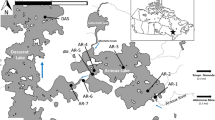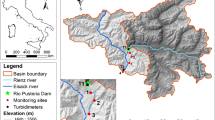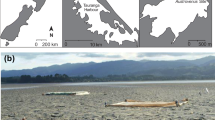Abstract
We compared naturally alkaline streams with limestone lithology to freestone streams with and without acid mine drainage (AMD) to predict benthic macroinvertebrate community recovery from AMD in limestone-treated watersheds. Surrogate-recovered (limestone) and, in many cases, freestone systems had significantly higher macroinvertebrate densities; diversity; taxa richness; Ephemeroptera, Plecoptera, and Trichoptera (EPT) taxa; EPT/chironomid ratios; scraper/collector–gatherer ratios; herbivores; collector–filterers; and scrapers. AMD-influenced systems had significantly greater numbers of Diptera and collector–gatherers. An entire trophic level (herbivores) was “restored” in surrogate-recovered streams, which also showed greater trophic specialization. Indicator analysis identified seven taxa (within Crustacea, Diptera, Nematoda, Trichoptera, and Ephemeroptera) as significant indicators of limestone systems and six taxa (within Ephemeroptera, Plecoptera, Tricoptera, Coleoptera, and Mollusca) as significant freestone indicators, all useful as biological indicators of recovery from AMD.
Similar content being viewed by others
References
Allard, M., & Moreau, G. (1987). Effects of experimental acidification on a lotic macroinvertebrate community. Hydrobiologia, 144, 37–49.
Arnold, D. E., & Gray, M. J. (1998). An operational and biological evaluation of the treatment of acid mine drainage in streams by limestone-bed diversion wells. University Park, PA: Pennsylvania Cooperative Fish and Wildlife Research Unit.
Barbour, M. T., Gerritsen, J., Snyder, B. D., & Stribling, J. B. (1999). Rapid bioassessment protocols for use in streams and wadeable rivers: periphyton, benthic macroinvertebrates, and fish (2nd ed). EPA 841-B-99-002. Washington, DC: USEPA Office of Water.
Cannon, W. E., & Kimmel, W. G. (1992). A comparison of fish and macroinvertebrate communities between an unpolluted stream and the recovery zone of a stream receiving acid mine drainage. Journal of the Pennsylvania Academy of Science, 66, 58–62.
Constanz, G. (2000). Grassroots-based watershed conservation in central Appalachia. Mountain Research and Development, 20, 122–125.
DeNocola, D. M., & Stapleton, M. G. (2002). Impact of acid mine drainage on benthic communities in streams: the relative roles of substratum vs. aqueous effects. Environmental Pollution, 119, 303–315.
Dufrêne, M., & Legendre, P. (1997). Species assemblages and indicator species: the need for a flexible asymmetrical approach. Ecological Monographs, 67, 345–366.
Earle, J., & Callaghan, T. (1998). Impacts of mine drainage on aquatic life, water uses, and man-made structures. In K. B. Brady, M. W. Smith, & J. Schueck (Eds.), Coal mine drainage prediction and pollution prevention in Pennsylvania (pp. 4-1–4-10). Harrisburg, PA: Pennsylvania Department of Environmental Protection.
Griffith, M. B., Perry, S. A., & Perry, W. B. (1994). Secondary production of macroinvertebrate shredders in headwater streams with different baseflow alkalinity. Journal of the North American Benthological Society, 13, 345–356.
Hainly, R. A., & Barker, J. L. (1993). Water quality of the upper West Branch Susquehanna River and tributary streams between Curwensville and Renovo, Pennsylvania, May and July 1984. USGS Water Resources Investigations Report 90-4011, Denver, Colorado.
Hainly, R. A., Truhlar, J. F., & Wetzel, K. L. (1989). Surface water quality in the West Branch Susquehanna River basin, Pennsylvania: an appraisal of areal and temporal variability from 1962 to 1982 in hydrologic accounting unit 020502. USGS Water Resources Investigations Report 85-4283, Denver, Colorado.
Hall, R. J., Liknes, G. E., Fiance, S. B., & Hendrey, G. R. (1980). Experimental acidification of a stream in the Hubbard Brook Experimental Forest, New Hampshire. Ecology, 61, 976–989.
Hellawell, J. M. (1986). Biological indicators of freshwater pollution and environmental management. London: Elsevier Publishing Company.
Herb, W. J., Brown, D. E., Shaw, L. C., & Becher, A. E. (1983). Hydrology of area 1, eastern coal province, Pennsylvania. USGS Water Resources Investigations Report 83-223, Denver, Colorado.
Hoiland, W. K., Rabe, F. W., & Biggam, R. C. (1994). Recovery of macroinvertebrate communities from metal pollution in the South Fork and mainstem of the Coeur d’Alene River, Idaho. Water Environment Research, 66, 84–88.
Hynes, H. B. (1960). The biology of polluted waters. Liverpool: Liverpool University Press.
Johnson, R. K., Wiederholm, T., & Rosenberg, D. M. (1993). Freshwater biomonitoring using individual organisms, populations, and species assemblages of benthic macroinvertebrates. In D. M. Rosenberg & V. H. Resh (Eds.), Freshwater biomonitoring and benthic macroinvertebrates (pp. 40–158). New York: Chapman and Hall.
Kimmel, W. G., Miller, C. A., & Moon, T. C. (1981). The impact of a deep-mine drainage on the water quality and biota of a small hard-water stream. Proceedings of the Pennsylvania Academy of Science, 55, 137–141.
Kruskal, J. B. (1964). Nonmetric multidimensional scaling: a numerical method. Psychometrika, 29, 115–129.
Lacroix, G. L. (1992). Mitigation of low stream pH and its effects on salmonids. Environmental Pollution, 78, 157–164.
Mather, P. M. (1976). Computational methods of multivariate analysis in physical geography. London: J. Wiley and Sons.
McCune, B., & Grace, J. B. (2002). Analysis of ecological communities. MjM Software Designs, Gleneden Beach, Oregon USA.
McCune, B., & Mefford, M. J. (1999). Multivariate analysis on the PC-Ord system, Version 4.34. MjM Software Designs, Gleneden Beach, Oregon USA.
McCune, B., Rosentreter, R., Ponzetti, J. M., & Shaw, D. C. (2000). Epiphyte habitats in an old conifer forest in Western Washington, U.S.A. The Bryologist, 103, 417–427.
Merritt, R. W., & Cummins, K. W. (1996). An introduction to the aquatic insects of North America (3rd ed.). Dubuque, Iowa: Kendall/Hunt Publishing Co.
Mielke, P. W., Jr. (1984). Meteorological applications of permutation techniques based on distance functions, pp. 813–830. In P. R. Krishnaiah, & P. K. Sen (Eds.) Handbook of statistics (vol. 4, pp. 813–830). Amsterdam: Elsevier Science Publishers.
Minitab (1998). Minitab for windows (release 12). Minitab, Inc., State College, Pennsylvania.
Morris, M. R. (2003). Impact of acid mine drainage and its remediation of the chemistry and biology of a first-order stream in the Babb Creek watershed, Tioga County, PA. Honors Thesis, Lycoming College, Williamsport, Pennsylvania.
Office of Resources Management (ORM) (1979). The state water plan, subbasin 8, upper West Branch Susquehanna River. Bureau of Resources Programming, Department of Environmental Resources, Harrisburg, Pennsylvania.
Ohio Department of Natural Resources (OHDNR) (2007). Acid mine drainage abatement program. Available at http://dnr.state.oh.us/mineral/aml/acid.htm (12 April 2007).
Omernik, J. M. (1995). Ecoregions – a framework for environmental management. In W. S. Davis & T. P. Simon (Eds.), Biological assessment and criteria-tools for water resource planning and decision making (pp. 49–62). Boca Raton, FL: Lewis Publishers.
Palmer, M. A., & Allan, J. D. (2006). Restoring rivers. Issues in Science and Technology, 2006, 40–48.
Pennsylvania Department of Environmental Protection (PADEP) (2006). 2006 Pennsylvania integrated water quality monitoring and assessment report. Available at http://www.dep.state.pa.us. Keyword: “305b Report” (12 April 2007).
Raddum, G. G., Fjellheim, A., & Hesthagen, T. (1988). Monitoring of acidification by the use of aquatic organisms. Verhandlungen der Internationale Vereinigung fur Theoretische und Angewandte Limnologie, 23, 2291–2297.
Rossman, W., Wytovich, E., & Seif, J. M. (1997). Abandoned mines – Pennsylvania’s single biggest water pollution problem. Pennsylvania Department of Environmental Protection, Harrisburg, Pennsylvania. Available at http://www.dep.state.pa.us/dep/deputate/minres/bamr/mining_012397.htm (12 April 2007).
United States Environmental Protection Agency (USEPA) (2000). Mid-Atlantic highlands streams assessment. EPA 1903/R-00/015. U. S. Environmental Protection Agency Region 3, Philadelphia, Pennsylvania.
United States Geological Survey (USGS) (2003). USGS water data for the nation. National water information system: web interface. Available at http://waterdata.usgs.gov/nwis. (28 September 2007).
United States Geological Survey (USGS) (2005). National field manual for the collection of water-quality data: U. S. Geological Survey techniques of water-resources investigations, book 9. Reston Virginia: United States Geological Survey.
Waters, T. F. (2000). Wildstream: a natural history of the free flowing river. St. Paul, MN: Riparian Press.
Weaver, J. (2003). Wilson Creek water quality and biological assessment report. Grand Canyon Ecological Services, Wellsboro, Pennsylvania.
West Branch Susquehanna River Task Force (WBSRTF) (2005). West Branch Susquehanna River watershed: state of the watershed report. 5400-RE-DEP4015. Pennsylvania Department of Environmental Protection, Harrisburg, Pennsylvania.
Wiederholm, T. (1984). Responses of aquatic insects to environmental pollution. In V. H. Resh & D. M. Rosenberg (Eds.), The ecology of aquatic insects (pp. 508–557). New York: Praeger Publishing Company.
Author information
Authors and Affiliations
Corresponding author
Rights and permissions
About this article
Cite this article
Ross, R.M., Long, E.S. & Dropkin, D.S. Response of macroinvertebrate communities to remediation-simulating conditions in Pennsylvania streams influenced by acid mine drainage. Environ Monit Assess 145, 323–338 (2008). https://doi.org/10.1007/s10661-007-0042-3
Received:
Accepted:
Published:
Issue Date:
DOI: https://doi.org/10.1007/s10661-007-0042-3




